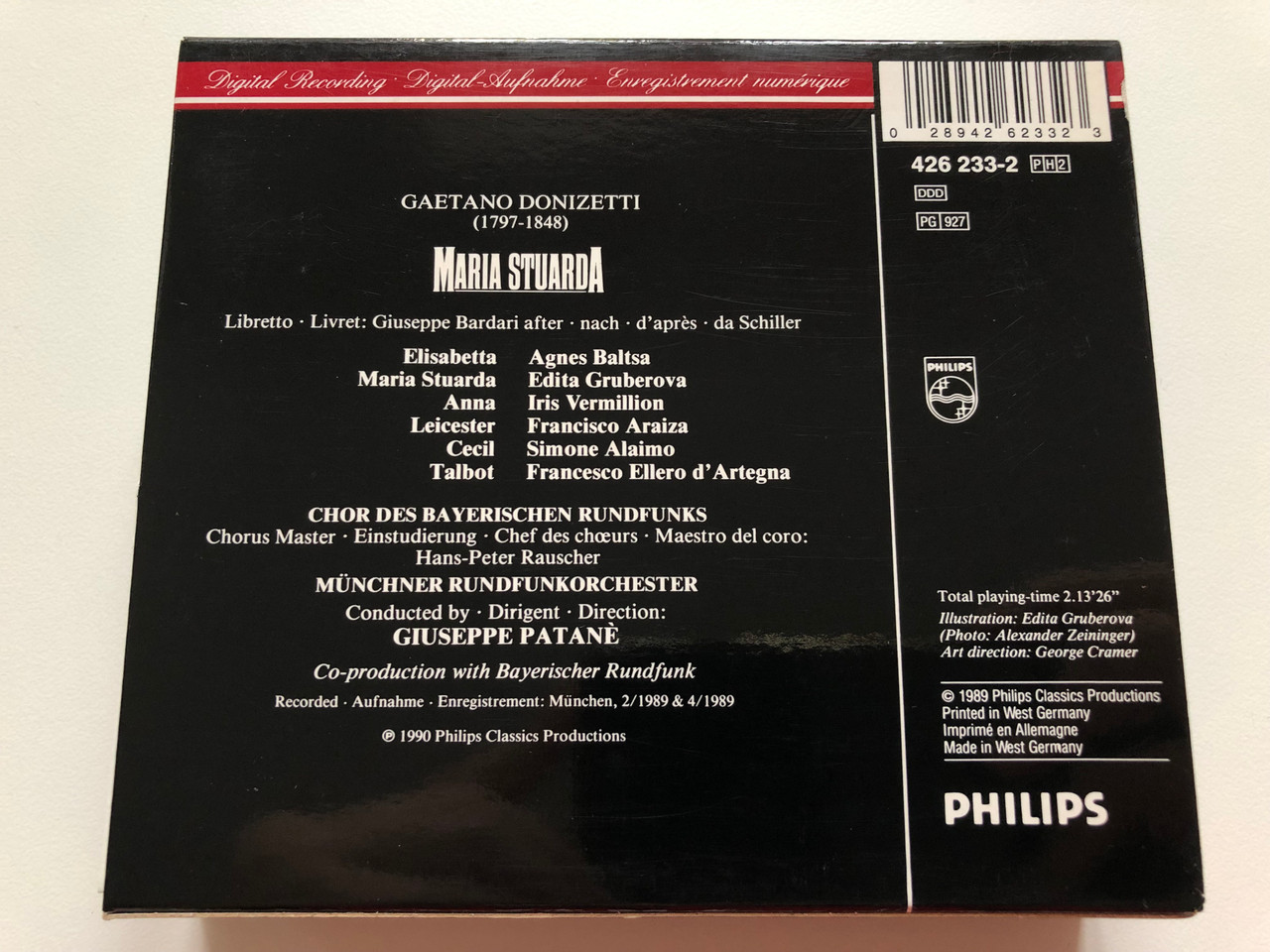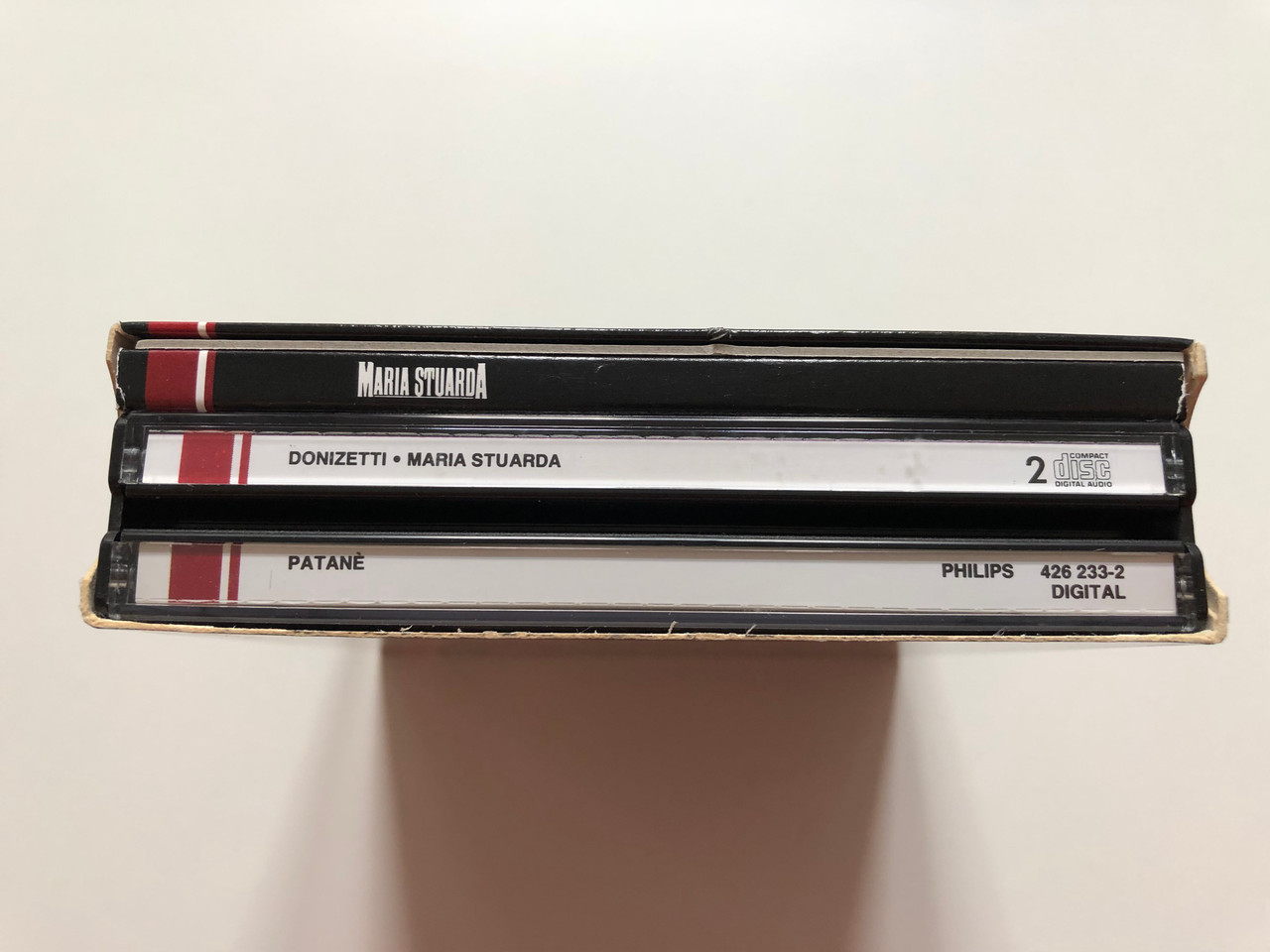Description
Donizetti - Maria Stuarda - Edita Gruberova, Agnes Baltsa, Francisco Araiza, Francsesco Ellero d'Artegna, Simone Alaimo, Iris Vermillion / Chor Des Bayerischen Rundfunks, Münchner Rundfunkorchester / Philips 2x Audio CD 1990 Stereo / 426 233-2
UPC 028942623323
Maria Stuarda (Mary Stuart) is a tragic opera (tragedia lirica), in two acts, by Gaetano Donizetti, to a libretto by Giuseppe Bardari, based on Andrea Maffei's translation of Friedrich Schiller's 1800 play Maria Stuart.
The opera is one of a number of operas by Donizetti which deal with the Tudor period in English history, including Anna Bolena (named for Henry VIII's second wife, Anne Boleyn), Roberto Devereux (named for a putative lover of Queen Elizabeth I of England) and Il castello di Kenilworth. The lead female characters of the operas Anna Bolena, Maria Stuarda, and Roberto Devereux are often referred to as the "Three Donizetti Queens". The story is loosely based on the lives of Mary, Queen of Scots (Mary Stuart) and her cousin Queen Elizabeth I. Schiller had invented the confrontation of the two Queens, who in fact never met.
After a series of problems surrounding its presentation in Naples after the final dress rehearsal – including having to be re-written for a totally different location, a different time period, and with Buondelmonte as its new title – Maria Stuarda as we know it today premiered on 30 December 1835 at La Scala in Milan.
| Label: | Philips – 426 233-2 |
|---|---|
| Format: |
2 x CD, Album, Box Set
|
| Country: | Germany |
| Released: | 1990 |
| Genre: | Classical |
| Style: | Opera |
Tracklist:
| Act 1 | |||
| 1-1 | Preludio | ||
| 1-2 | No. 1: Qui Si Attenda | ||
| 1-3 | No. 2: Sí, Vuol Di Francia Il Rege | ||
| 1-4 | No. 3: Fra Noi Perché Non Veggio Leicester? | ||
| 1-5 | No. 4: Questa Imago, Questo Foglio | ||
| 1-6 | No. 5: Sei Tu Confuso? | ||
| 1-7 | Era D'Amor L'Immagine | ||
|
Act 2 |
|||
| 1-8 | No. 6: Allenta Il Pié, Regina | ||
| 1-9 | O Nube Che Lieve Per L'Aria | ||
| 1-10 | No. 7: Ah! Non M'Inganna La Gioia! | ||
| 1-11 | Da Tutti Abbandonata | ||
| 1-12 | No. 8: Qual Loco É Questo? | ||
| 1-13 | No. 9: É Sempre La Stessa | ||
| 1-14 | No. 10: Deh! I'Accogli | ||
| 1-15 | No. 11: Va, Preaparati, Furente | ||
|
Act 3 |
|||
| 2-1 | E Pensi? E Tardi? | ||
| 2-2 | Quella Vita A Me Funesta | ||
| 2-3 | Regina! A Lei S'Affretta Il Supplizio | ||
| 2-4 | D'Una Sorella, O Barbara | ||
| 2-5 | La Perfida Insultarmi Volea Nel Mio Sepolcro | ||
| 2-6 | O Mio Buon Talbot! | ||
| 2-7 | Quando Di Luce Rosea | ||
| 2-8 | Un'Altra Colpa A Piangere | ||
| 2-9 | Vedeste? ... Vedemmo (Coro) | ||
| 2-10 | Anna! Qui Più Sommessi Favellate | ||
| 2-11 | Deh! Tu Di Un Umile Preghiera Il Suono | ||
| 2-12 | O Colpo!... E' Gia Vicino Del Tuo Morir L'Istante | ||
| 2-13 | D'Un Cor Che Muore Reca Il Perdono | ||
| 2-14 | Giunge Il Conte | ||
| 2-15 | Ah! Se Un Giorno Da Queste Ritorte |
- Art Direction – George Cramer
- Baritone Vocals – Simone Alaimo
- Bass Vocals – Francesco Ellero D'Artegna
- Chorus – Chor Des Bayerischen Rundfunks
- Chorus Master – Hans-Peter Rauscher
- Co-producer – Bayerischer Rundfunk
- Composed By – Gaetano Donizetti
- Conductor – Giuseppe Patanè
- Libretto By – Giuseppe Bardari
- Mezzo-soprano Vocals – Agnes Baltsa, Iris Vermillion
- Orchestra – Münchner Rundfunkorchester
- Photography By – Alexander Zeininger
- Soprano Vocals – Edita Gruberova
- Tenor Vocals – Francisco Araiza
- Text By – Schiller






























